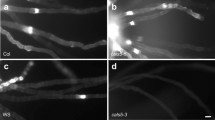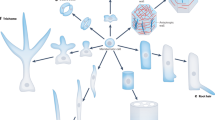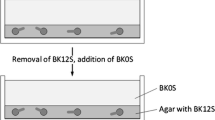Abstract
Cellulose is the principal component of the load-bearing system in primary plant cell walls. The great resistance to tensile forces of this polysaccharide and its embedding in matrix components make the cell wall a material similar to a fiber composite. In the rapidly growing pollen tube, the amount of cellulose in the cell wall is untypically low. Therefore, we want to investigate whether the load-bearing function of cellulose is nevertheless important for the architecture of this cell. Enzymatic digestion with cellulase and inhibition of cellulose crystal formation with CGA (1-cyclohexyl-5-(2,3,4,5,6-pentafluorophenoxy)-1λ4,2,4,6-thiatriazin-3-amine) resulted in the formation of tubes with increased diameter in Solanum chacoense and Lilium orientalis when present during germination. In pre-germinated tubes, application of both agents resulted in the transient arrest of growth accompanied by the formation of an apical swelling indicating a role in the mechanical stabilization of this cellular region. Once growth resumed in the presence of cellulase, however, the cell wall in the newly formed tube showed increased amounts of pectins, possibly to compensate for the reduced amount of cellulose. Scanning electron microscopy of pollen tubes subjected to digestion of matrix polysaccharides revealed the mechanical anisotropy of the cell wall. In both Lilium and Solanum, the angle of highest stability revealed by crack formation was significantly below 45°, an indication that in the mature part of the cell cellulose may not the main stress-bearing component against turgor pressure induced tensile stress in circumferential direction.










Similar content being viewed by others
References
Anderson JR, Barnes WS, Bedinger P (2002) 2,6-Dichlorbenzonitrile, a cellulose biosynthesis inhibitor, affects morphology and structural integrity of petunia and lily pollen tubes. J Plant Physiol 159:61–67
Baskin T (2005) Anisotropic expansion of the plant cell wall. Annu Rev Cell Dev Biol 21:203–222
Baskin TI, Meekes HTHM, Liang BM, Sharp RE (1999) Regulation of growth anisotropy in well-watered and water-stressed maize roots. II. Role of cortical microtubules and cellulose microfibrils. Plant Physiol 119:681–692
Brewbaker JL, Kwack BH (1963) The essential role of calcium ion in pollen germination and pollen tube growth. Am J Bot 50:859–865
Burk DH, Ye Z-H (2002) Alteration of oriented deposition of cellulose microfibrils by mutation of a katanin-like microtubule-severing protein. Plant Cell 14:2145–2160
Chebli Y, Geitmann A (2007) Mechanical principles governing pollen tube growth. Funct Plant Sci Biotechnol 1:232–245
Delmer DP (1987) Cellulose biosynthesis. Annu Rev Plant Physiol 38:259–290
Delmer DP, Read SM, Cooper G (1987) Identification of a receptor protein in cotton fibers for the herbicide 2,6-dichlorobenzonitrile. Plant Physiol 84:415–420
Derksen J, Li Y-Q, Knuiman B, Geurts H (1999) The wall of Pinus sylvestris L. pollen tubes. Protoplasma 208:26–36
Dumais J, Long SR, Shaw SL (2004) The mechanics of surface expansion anisotropy in Medicago truncatula root hairs. Plant Physiol 136:3266–3275
Emons AMC, Mulder BM (1998) The making of the architecture of the plant cell wall: how cells exploit geometry. Plant Biol 95:7215–7219
Emons AMC, Mulder BM (2000) How the deposition of cellulose microfibrils builds cell wall architecture. Trends Plant Sci 5:35–40
Ferguson C, Teeri TT, Siika-aho M, Read SM, Bacic A (1998) Location of cellulose and callose in pollen tubes and grains of Nicotiana tabacum. Planta 206:452–460
Geitmann A, Ortega JKE (2009) Mechanics and modeling of plant cell growth. Trends Plant Sci 14(9)
Geitmann A, Parre E (2004) The local cytomechanical properties of growing pollen tubes correspond to the axial distribution of structural cellular elements. Sex Plant Reprod 17:9–16
Geitmann A, Steer MW (2006) The architecture and properties of the pollen tube cell wall. In: Malhó R (ed) The pollen tube: a cellular and molecular perspective. Plant cell monographs, vol 3. Springer, Berlin, Heidelberg, pp 177–200
Green PB (1962) Mechanism for plant cellular morphogenesis. Science 138:1404–1405
Heslop-Harrison J (1987) Pollen germination and pollen-tube growth. Int Rev Cytol 107:1–78
His I, Driouich A, Nicol F, Jauneau A, Höfte H (2001) Altered pectin composition in primary cell walls of korrigan, a dwarf mutant of Arabidopsis deficient in a membrane-bound endo-1, 4-β-glucanase. Planta 212:348–358
Holdaway-Clarke TL, Hepler PK (2003) Control of pollen tube growth: role of ion gradients and fluxes. New Phytol 159:539–563
Jones RM (1999) Mechanics of composite materials. Taylor and Francis, London
Kerstens S, Decraemer WF, Verbelen JP (2001) Cell walls at the plant surface behave mechanically like fiber-reinforced composite materials. Plant Physiol 127:381–385
Knox JP, Linstead PJ, King J, Cooper C, Roberts K (1990) Pectin esterification is spatially regulated both within cell walls and between developing tissues of root apices. Planta 181:512–521
Kroh M, Knuiman B (1982) Ultrastructure of cell wall and plugs of tobacco pollen tubes after chemical extraction of polysaccharides. Planta 154:241–250
Kurek I, Kawagoe Y, Jacob-Wilk D, Doblin M, Delmer D (2002) Dimerization of cotton fiber cellulose synthase catalytic subunits occurs via oxidation of the zinc-binding domains. Proc Natl Acad Sci USA 99:11109–11114
Lazzaro MD, Donohue JM, Soodavar FM (2003) Disruption of cellulose synthesis by isoxaben causes tip swelling and disorganixes cortical microtubules in elongating conifer pollen tubes. Protplasma 220:201–207
Lloyd C (2006) Microtubules make tracks for cellulose. Science 312:1482–1483
Lord E (2000) Adhesion and cell movement during pollination: cherchez la femme. Trends Plant Sci 5:368–373
Malhó R (2006) The pollen tube: a cellular and molecular perspective, vol 3. Springer Verlag, Berlin, Heidelberg
Mascarenhas JP (1993) Molecular mechanisms of pollen tube growth and differentiation. Plant Cell 5:1303–1314
McCann MC, Roberts K (1991) Architecture of the primary cell wall. In: Lloyd CW (ed) The cytoskeletal basis of plant growth and form. Academic Press, London, pp 109–129
O’Kelley JC, Carr PH (1954) An electron micrographic study of the cell walls of elongating cotton fibers, root hairs, and pollen tubes. Am J Bot 41:261–264
Parre E, Geitmann A (2005) More than a leak sealant—the physical properties of callose in pollen tubes. Plant Physiol 137:274–286
Sassen MMA (1964) Fine structure of Petunia pollen grain and pollen tube. Acta Bot Neerl 13:175–181
Schlüpmann H, Bacic A, Read SM (1994) Uridine diphosphate glucose metabolism and callose synthesis in cultured pollen tubes of Nicotiana alata Link et Otto. Plant Phsyiol 105:659–670
Shedletzky E, Shmuel M, Delmer DP, Lamport DTA (1990) Adaptation and growth of tomato cells on the herbicide 2,6-dichlorobenzonitrile leads to production of unique cell-walls virtually lacking a cellulose-xyloglucan network. Plant Physiol 94:980–987
Shedletzky E, Shmuel M, Trainin T, Kalman S, Delmer DP (1992) Cell wall structure in cells adapted to growth on the cellulose-synthesis inhibitor 2,6-dichlorobenzonitrile: a comparison between two dicotyledonous plants and a graminaceous monocot. Plant Physiol 100:120–130
Shivanna KR, Johri BM (1985) The angiosperm pollen. Wiley Eastern Limited, New Delhi
Steer MW, Steer JM (1989) Pollen tube tip growth. New Phytol 111:323–358
Sugimoto K, Williamson RE, Wasteneys GO (2000) New techniques enable comparative analysis of microtubule orientation, wall texture, and growth rate in intact roots of Arabidopsis. Plant Physiol 124:1493–1506
Suslov D, Verbelen JP (2006) Cellulose orientation determines mechanical anisotropy in onion epidermis cell walls. J Exp Bot 57:2183–2192
VandenBosch KA, Bradley DJ, Knox JP, Perotto S, Butcher GW, Brewin NJ (1989) Common components of the infection thread matrix and the intercellular space identified by immunocytochemical analysis of pea nodules and uninfected roots. EMBO J 8:335–342
Wilsen KL, Hepler PK (2007) Sperm delivery in flowering plants. Bioscience 57:835–844
Zerzour R, Kroeger JH, Geitmann A (2009) Polar growth in pollen tubes is associated with spatially confined dynamic changes in cell mechanical properties. Dev Biol (in press). doi:10.1016/j.ydbio.2009.07.044
Acknowledgments
Work in the Geitmann lab is supported by grants from the Natural Sciences and Engineering Research Council of Canada (NSERC), the Fonds Québécois de la Recherche sur la Nature et les Technologies (FQRNT), and the Human Frontier Science Program (HFSP). The authors would like to thank Louise Pelletier for technical assistance with SEM and Jens Kroeger for discussions about physico-mechanical considerations. Thanks to Jean Wenger (Syngenta, Basel, Switzerland) for the gift of CGA and to Paul Knox, University of Leeds, Great Britain, for the antibodies JIM5 and JIM7.
Author information
Authors and Affiliations
Corresponding author
Additional information
Communicated by Scott Russell.
Rights and permissions
About this article
Cite this article
Aouar, L., Chebli, Y. & Geitmann, A. Morphogenesis of complex plant cell shapes: the mechanical role of crystalline cellulose in growing pollen tubes. Sex Plant Reprod 23, 15–27 (2010). https://doi.org/10.1007/s00497-009-0110-7
Received:
Accepted:
Published:
Issue Date:
DOI: https://doi.org/10.1007/s00497-009-0110-7




